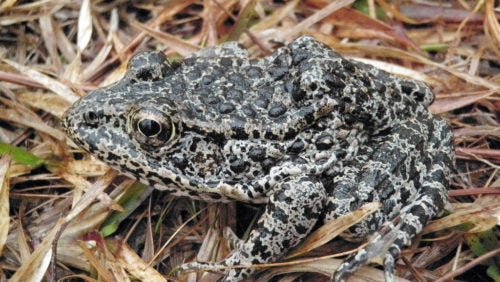The Spotted Gopher Frog: A Supreme Court Reflection
October 5, 2018 by De Vann Sago

A spotted gopher frog sitting on a a dried patch of grass
By Rebecca Strauss, Staff Contributor.
The Supreme Court opened the 2018 term with a case on the Endangered Species Act, focusing on the dusky gopher frog. With only eight sitting justices, what are the Court's options?
The ninth chair was conspicuously vacant when the Supreme Court opened the 2018 term on Monday, October 1. While the FBI continued its investigation into Brett Kavanaugh, the Supreme Court heard Weyerhaeuser Company v. U.S. Fish and Wildlife Service, a case considering the Endangered Species Act. The case centered around the dusky gopher frog, an endangered species found in the forested wetlands of Louisiana and Alabama.[1]
The Endangered Species Act (ESA) requires the Fish and Wildlife Service (FWS) list the species in need of protection and name their critical habitat. The Act aims to conserve not only bare survival of the species, but to support recovery as well.[2] In 2012, the service designated a swath of land in Louisiana as critical habitat. While the frog does not currently live there, it is a potential habitat because it has rare “ephemeral ponds,” which the dusky gopher frog needs to breed.[3] The FWS contends that with “reasonable efforts,” the area could be restored.[4] The Weyerhaeuser Company owns a portion of the designated land. They responded that they lost tens of millions of dollars in value in the land when it was deemed “critical habitat.”[5] The Court considered two issues: whether the service’s designation violated the ESA and whether the Agency’s decision not to exclude the particular section of land was reviewable.
Before Judge Kavanaugh’s confirmation vote was delayed, environmentalists feared that the conservative block would vote to severely limit the ESA. Now, with only eight judges on the court and a 4-4 ideological split, it seems less likely that the Court will make sweeping changes. But that still raises the question: what will the Court do now?
The Justices could split 4-4, leaving the Fifth Circuit’s decision for the FWS binding. The Fifth Circuit upheld the service’s interpretation that the critical habitat was essential to the conservation of the species.[6] It remains to be seen whether the Justices want to start the term with a split decision. They could also reach a narrow, fact specific decision. The questions from the Justices were all over the place, so it is hard to speculate on what grounds they would find commonality, but it is possible they will find commonality in chambers.[7]
While most of the questions posed during oral arguments centered on the definition of habitat, the questions suggested that the justices disagree as to the future of the ESA and what should be considered critical habitat. So, the Court might rule just on the second question. They could find that the Agency’s decision is reviewable and remand the first issue back to the Circuit Court to determine if the Agency’s decision was arbitrary and capricious. The Court has recently held unanimously the necessity of judicial review in Clean Water Act cases.[8] It seems reasonable for the Court to continue prioritizing judicial review, thereby avoiding the harder question about the ESA. However, Chevron was not mentioned once, even though the Fifth Circuit relied on it to uphold the FWS’s decision.[9]
For now, all we can do is speculate while we wait for the Court to issue a decision. If Judge Kavanaugh is confirmed and becomes Justice Kavanaugh, the delay appears to have at least saved the dusky gopher frog.
[1]See Lisa Heinzerling, Argument preview: Justices to consider critical-habitat designation for endangered frog, SCOTUSBLOG (Sept. 24, 2018, 11:20 AM), http://www.scotusblog.com/2018/09/argument-preview-justices-to-consider-critical-habitat-designation-for-endangered-frog/.
[2]See id.
[3]See id.
[4]See id.
[5]Transcript of Oral argument at 14, Weyerhaeuser Co. v. U.S. Fish & Wildlife Serv., 138 S. Ct. 924 (2018) (No. 17-71), https://www.supremecourt.gov/oral_arguments/argument_transcripts/2018/17-71_4f15.pdf.
[6]See Markle Interests, L.L.C. v. United States Fish & Wildlife Serv., 827 F.3d 452, 467 (5th Cir. 2016), cert. granted sub nom. Weyerhaeuser Co. v. U.S. Fish & Wildlife Serv., 138 S. Ct. 924 (2018).
[7]Transcript of Oral argument, Weyerhaeuser Co. v. U.S. Fish & Wildlife Serv., 138 S. Ct. 924 (2018) (No. 17-71), https://www.supremecourt.gov/oral_arguments/argument_transcripts/2018/17-71_4f15.pdf.
[8]See U.S. Army Corps of Engineers v. Hawkes Co., 136 S. Ct. 1807 (2016); Sackett v. E.P.A., 132 S. Ct. 1367 (2012).
[9]See Lisa Heinzerling, Argument analysis: Justices jostle over endangered frog’s critical habitat, SCOTUSBLOG (Oct. 1, 2018, 10:05 PM), http://www.scotusblog.com/2018/10/argument-analysis-justices-jostle-over-endangered-frogs-critical-habitat.
Chevron, U.S.A., Inc. v. Nat. Res. Def. Council, Inc., 467 U.S. 837, (1984) held that agency interpretations of ambiguity in statutes are entitled to deference.

